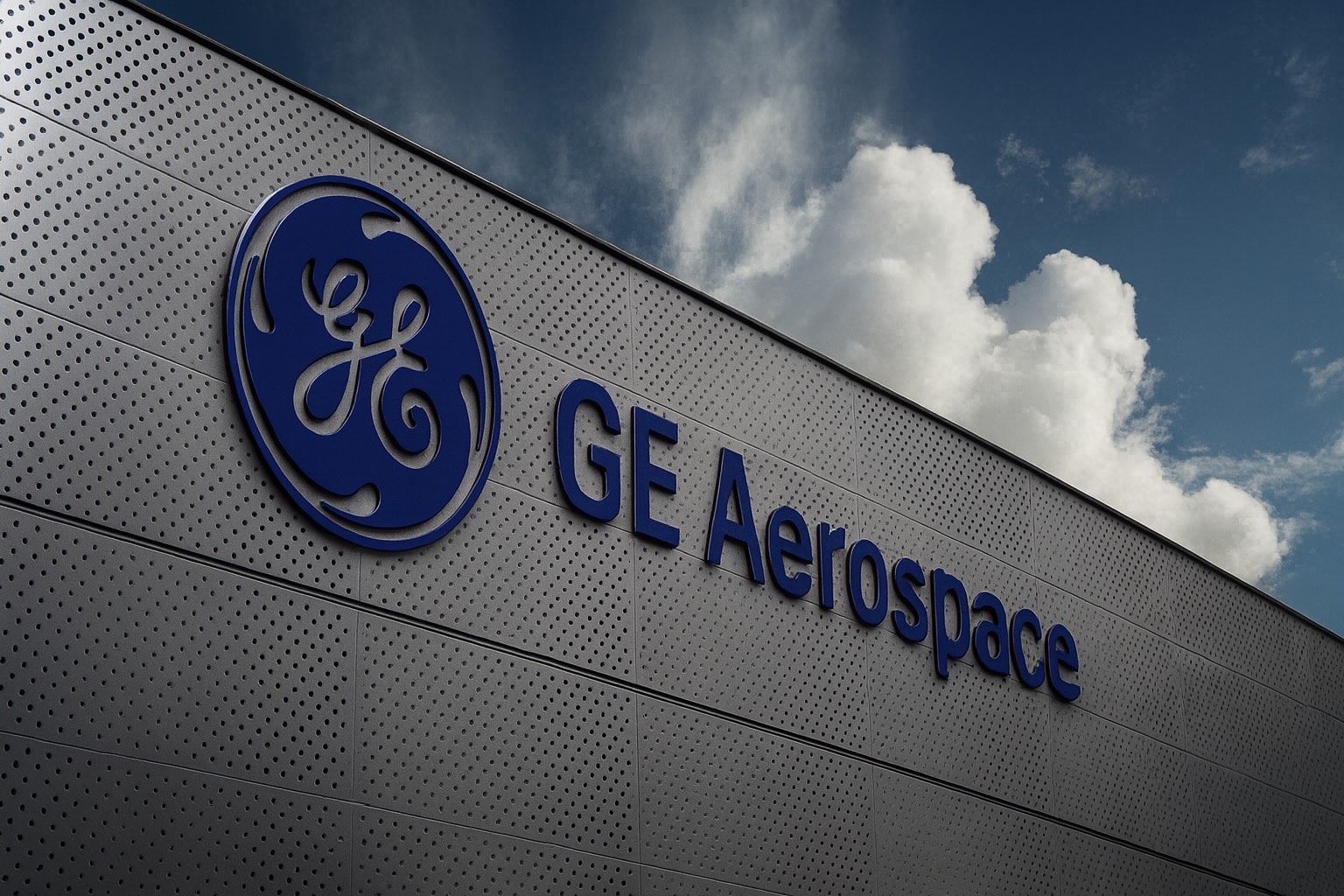- Shares Surge on Q3 Beat: GE Aerospace (NYSE: GE) stock jumped to a record intraday high (~$316) on Oct. 21 after the company reported far stronger-than-expected third-quarter results [1] [2]. Adjusted EPS was $1.66 (up 44% year-over-year), easily topping the ~$1.46 consensus, and revenue climbed 24% to $12.2 billion [3] [4].
- Guidance Raised: GE also lifted its full-year 2025 outlook. Management now expects adjusted earnings of $6.00–$6.20 per share (up from $5.60–$5.80), reflecting confidence in continued engine sales and services [5] [6].
- Stock Performance: As of mid-day Oct. 21, GE traded around $304 (after a premarket rally) – about 2% above Monday’s close (~$302.68) [7] [8]. The shares are up roughly 78% year-to-date, one of the best gains among large industrials, as GE refocused on jet engines after spinning off its energy and healthcare units in 2024 [9] [10].
- Analyst Confidence: Wall Street has been increasingly bullish. About 15 of 17 analysts rate GE Aerospace a “Buy” (consensus “Moderate Buy”), with an average 12-month target around $264. Notable price targets include $305 (Goldman Sachs) and $321 (UBS) [11] [12]. FactSet’s consensus for YE2025 is roughly $317 [13]. Still, some caution that the current valuation (~35–40× forward earnings) leaves little room for error [14].
- Major Contracts & Tailwinds: Recent wins are bolstering GE’s outlook. In mid-Oct. GE announced a 7‑year AerCap deal to service its GE9X and other engines, and in March it secured a $5 billion USAF contract for F110 fighter engines [15] [16]. The broader aerospace cycle is strong: Boeing has FAA approval to boost 737 MAX production to 42 jets/month (driving more GE-Safran LEAP engine orders) [17], and global air travel is recovering. On the defense side, conflicts in Ukraine and the Middle East have spurred arms spending – Lockheed Martin and RTX just reported surging profits thanks to these geopolitical tailwinds [18].
- CEO Outlook: GE’s CEO Larry Culp emphasized that airline customers are optimistic. He told Reuters that dozens of carrier executives were “all upbeat about the outlook” for Q4 and next year, adding “we’re going to be busy” meeting engine demand [19]. Culp also credited GE’s lean “Flight Deck” operating program with boosting production and services (yielding “strong services and engine output” this quarter) [20].
Blowout Q3 Earnings Fuel Rally
GE Aerospace’s third-quarter report far surpassed forecasts. The company logged $1.66 in adjusted earnings per share, up 44% from a year ago, on revenue of about $12.2 billion [21] [22]. Both measures handily beat analysts’ targets (consensus had been roughly $1.45 EPS on $10.9B revenue) [23]. A Zacks/Nasdaq analysis confirms these beats and notes order growth across commercial and defense segments [24]. In response, GE raised its full-year profit outlook again – now expecting $6.00–$6.20 in adjusted EPS for 2025 (versus an earlier $5.60–$5.80 range) [25] [26].
Management highlighted strong backlog and tighter cost controls. CEO Larry Culp pointed to the firm’s “Flight Deck” lean transformation program as bearing fruit – saying “daily progress compounds to drive meaningful results” and that the company saw “strong services and engine output” this quarter [27]. (GE’s spare-parts and maintenance business on older jets is highly profitable.) With record engine deliveries and aftermarkets, the company is now anticipating “high-teens” revenue growth for 2025, up from mid-teens previously projected [28] [29].
Stock Sets New High; Analysts Ramp Up
Investors rewarded the results. GE Aerospace stock briefly hit an intraday record of $316.53 on Oct. 21 (a ~5% one-day jump) [30]. It later settled near $304, still up about 2% on the day [31]. That rally builds on a year-long surge: GE closed around $300 on Oct. 17, up from a low of $159 earlier in 2025 [32]. Trading volumes remain heavy and technical indicators are bullish, reflecting solid investor confidence.
Analysts have increasingly raised their outlooks. Goldman Sachs recently boosted its target to $305, UBS to $321 (both ratings Buy), and RBC, TD Cowen and others sit at similar levels around $300 [33]. By contrast, the modest “hold” or cautious calls come with targets in the mid-$250s. Overall, analysts’ 12-month consensus hovers in the low-to-mid $300s. Many note that GE’s engine franchise – the joint CFM venture supplying Boeing 737 and Airbus A320neo jets – is essentially undisputed (CFM won nearly all 737 MAX and A320neo orders) [34]. The nearly $175 billion engine order backlog provides long-term revenue visibility [35].
Nonetheless, some experts urge caution. At ~36–40× forward earnings, GE trades at a lofty multiple [36]. Quant models (e.g. CoinCodex) offer mixed forecasts ranging from bearish (~$241 in 2026) to bullish (~$297) scenarios [37]. Fundamental risks include possible supply-chain hiccups, tariff pressures, or slower aircraft demand. But for now the consensus view is that the near-term catalysts – continued backlog fulfillment, strong airline demand, and prudent capital returns – will keep the momentum going.
Sector Tailwinds: Travel Rebound and Defense Spending
GE Aerospace benefits from broader aerospace and defense trends. In commercial aviation, Boeing and Airbus are ramping up production: Boeing just won FAA approval to boost 737 MAX output to 42 jets per month [38], which will drive corresponding demand for GE’s LEAP engines. Globally, passenger traffic is approaching (and in some markets exceeding) pre-pandemic levels, fueling orders and maintenance work. GE’s vast installed engine base means it earns service revenue long after jets are sold.
On the military side, geopolitical tensions have lifted spending. In the U.S., a protracted Ukraine war and Middle East conflicts have airlines and governments investing heavily in defense. Major arms companies like Lockheed Martin and RTX recently reported much higher profits as demand for fighter jets, missiles and other hardware surged amid these conflicts [39]. GE’s engines power key platforms like the F-15, F-16 and F-35, so higher defense budgets directly translate to engine contracts and support services. Indeed, GE won a record “up to $5 billion” contract for USAF F-15/F-16 engines earlier this year [40], and the company continues negotiating deals with allies.
Because of these trends, peer engine-makers have also boomed. In the UK, Rolls-Royce’s shares nearly doubled in 2025 on engine and defense sales, and it raised its profit outlook after reporting a 50% jump in half-year profit [41]. Pratt & Whitney (RTX) and other suppliers similarly benefit from the jet-cycle. In this environment, GE Aerospace – newly a pure-play company after GE’s April 2024 spinoff of its other units – is being valued more like a high-growth tech stock than a legacy conglomerate [42] [43]. Investors point out that GE’s former divisions (power, healthcare) had dragged down its stock; now as “GE Aerospace,” the focus is squarely on engines and returns.
Outlook: Analysts Say “Busy” Year Ahead
Looking ahead, nearly everyone is watching the upcoming Q4 outlook. Management has indicated airlines are lining up orders: Culp told reporters that airline CEOs he met were “upbeat” about 2026, and reiterated that demand is overwhelming – in his words, “demand isn’t our challenge” [44]. He expects 2026 to be another busy year. Wall Street forecasters generally expect GE to keep beating estimates; the company had positive “earnings surprise” in each of the last four quarters and analysts have been inching estimates up into this period [45].
Expert forecasts see the stock staying elevated. Short-term moves will hinge on any surprises in Q3 results (e.g. guidance for Q4 or 2026). If GE repeats its history of beats (or even guides higher), the $300s zone may test new highs. In the midterm, the average 12-month price targets are in the low $300s, implying modest upside from current levels [46]. More optimistic models (assuming flawless execution) project GE could hit the $600s by 2030 as it delivers decades of high-margin service revenues [47] [48].
For the average investor, the picture is clear: GE Aerospace appears to be leading a sector rebound. Its stock performance “reflects broad optimism,” according to one market note [49] [50]. Still, some analysts caution that with much good news already baked in, future growth must arrive as forecast – and any hiccup could give early buyers pause. The consensus view is that GE’s fortunes will track global air travel and defense spending: as long as airlines ramp up fleets and militaries spend, GE Aerospace has strong wind at its back [51] [52].
Sources: Q3 earnings reports and press releases; Reuters, Investopedia and Nasdaq financial news on GE Q3 results [53] [54]; industry analysis (TS2.tech) [55] [56]; and market data (stock price history) [57]. Each fact is cited to its source.
References
1. www.investopedia.com, 2. www.nasdaq.com, 3. www.investopedia.com, 4. www.nasdaq.com, 5. www.investopedia.com, 6. www.reuters.com, 7. www.investopedia.com, 8. www.investing.com, 9. ts2.tech, 10. ts2.tech, 11. ts2.tech, 12. ts2.tech, 13. ts2.tech, 14. ts2.tech, 15. ts2.tech, 16. www.reuters.com, 17. ts2.tech, 18. www.reuters.com, 19. www.reuters.com, 20. www.investopedia.com, 21. www.investopedia.com, 22. www.nasdaq.com, 23. www.investopedia.com, 24. www.nasdaq.com, 25. www.investopedia.com, 26. www.reuters.com, 27. www.investopedia.com, 28. www.investopedia.com, 29. www.reuters.com, 30. www.investopedia.com, 31. www.investing.com, 32. ts2.tech, 33. ts2.tech, 34. ts2.tech, 35. ts2.tech, 36. ts2.tech, 37. ts2.tech, 38. ts2.tech, 39. www.reuters.com, 40. www.reuters.com, 41. ts2.tech, 42. ts2.tech, 43. ts2.tech, 44. www.reuters.com, 45. ts2.tech, 46. ts2.tech, 47. ts2.tech, 48. ts2.tech, 49. www.nasdaq.com, 50. ts2.tech, 51. ts2.tech, 52. www.reuters.com, 53. www.investopedia.com, 54. www.reuters.com, 55. ts2.tech, 56. ts2.tech, 57. www.investing.com










